Plastic welding
Frequently asked questions about plastic welding
What types of plastic can be welded?
Before considering joining plastics, it’s essential to know their chemical formulation, so as to know which techniques and equipment can be used. In fact, only the thermoplastics family has the characteristics required for viable welds. By definition, it includes all plastic materials that can be formed, deformed or welded by increasing the temperature to which they are subjected.
Thermoplastics account for around 80% of the plastics currently produced worldwide, with a few flagship materials:
- Polyvinyl chloride (PVC) is used to produce pipes, doors, windows and floor coverings.
- Polyethylene terephthalate (PET) is used as a raw material in the production of bottles, textile fibers and disposable packaging.
- Polypropylene (PP) is used to manufacture spare parts, particularly for the automotive industry.
- Polystyrene (PS) or Frigolite is used for the production of floating objects and for thermal insulation.
Only the chemical formulation of the raw materials or parts supplied can differentiate between soft and hard plastics. Empirically, the distinction is difficult to make, since the same molecules can be used to form both soft and hard plastics. However, these methods are not suitable for all levels of rigidity.
Without drawing up a list of the processes used in thermoplastic welding, it is possible to note the following characteristics:
- Hot gas welding is suitable for the hardest plastics, with a gun acting as a flashlight and a rod to add material.
- Pressure bottom welding is particularly effective when working with thin plastic films.
- High-frequency or ultrasonic welding for many thermoplastics using dedicated equipment.

How does flexible plastic welding (PVC plastic sheeting, etc.) work?
Depending on the nature of the assembly or repair to be carried out, and the size of the various pieces to be welded, the process to be applied and the tool to be used will differ. One of the most widely used joining techniques is hot-air welding of materials. The process is based on the addition of material, often in the form of fine rods, which is used to join the various pieces of tarpaulin or film.
The two parts to be joined must lie flat on the floor and the rod must be perpendicular to them. A hot-air flashlight (or gun) is used to heat both the areas to be bonded and the tip of the plastic rod. The flashlight and the material rod must be advanced simultaneously along the welding line, to ensure quality work. This is a complex process, requiring precision and good tool control.
High-frequency (HF) or ultrasonic welding is preferable for large-scale plastic assemblies. The difference lies in the way the plastic is heated internally, right up to the material’s melting point. With the ultrasonic method, heating is achieved by emitting vibratory waves (between 20 and 70 kHz) into the core of the material, which heats up faster than the periphery. With the high-frequency method, an electromagnetic field is emitted at the surface to be welded.
These two processes have the same advantages, which are as follows:
- high-speed assembly of plastic parts,
- rapid temperature rise of materials up to the melting point only of the areas to be joined,
- production based on the use of easy-to-use equipment that operates autonomously or semi-autonomously,
- precise work, whatever the shape of the joint or repair to be made.
How to weld synthetic fibers and waxed fabrics?
There are many uses for thermoplastic derivatives, textile fibers or a mixture of these two types of materials:
- most garments made from synthetic fibers,
- packaging for meat preservation,
- certain types of canvas used in many fields (truck tarpaulins, tents, inflatable pool covers, boat sails….).
For plastics that melt at temperatures below 200°C, most welding techniques can be used. This is particularly true of polypropylene (PP), most polyamides (PA) and polyurethane derivatives (PU). With the exception of certain forms of polypropylene, high-frequency or ultrasonic processes are often chosen. However, there are a number of rod models available in these materials for more conventional heat-sealing.
What equipment should you use to weld plastics?
Depending on the characteristics of the joint to be made, different types of welding machines can be used. Matrelec offers a wide range of machines to meet every need in this field, using high-frequency technology:
- The HF Initial range is quite comprehensive, with equipment that can work on small welds as well as long seams. It includes the easiest-to-handle and most energy-efficient machines of all those offered by Matrelec.
- The HF Premium range is made up of machines with different platens, enabling faster storage and welding of items for high production volumes. This range is ideal for inflatables, safety equipment and automotive parts.
- The HF Chrono range is designed for the highest production speeds, particularly for blister packs. These machines give priority to speed of execution: up to 100 products per minute, depending on object dimensions.
- The HF Absolute range offers complete tools for high levels of automation. They are especially suited to the assembly of flexible products (label holders, notebook covers, etc.) and can work on formats up to 900mm by 1100mm.
- Forsstrom HF welding rails are suitable for the largest formats to be welded: advertising posters, tarpaulins, large canvases… Forsstrom brand equipment is renowned for its reliability in the production of large series.
